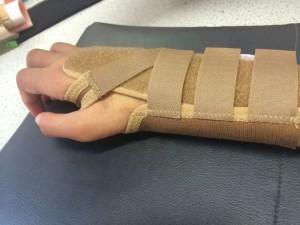One of my favorite things about 3D printing is the fact that it provides the ability to make big impacts on the lives of a relatively small group of people. One of the most exciting uses for 3D printers is within the medical field, and more specifically in creating customized and in many cases improved versions of assistive or prosthetic devices. In many cases those with disabilities need to use mass-produced devices and have them adapted to their specific injury, which can often cause discomfort or not produce the type of support or help that is actually needed. However 3D printing custom assistive devices can help disabled patients create a device that is suited to them exactly, and can be personalized to the user’s specific tastes.
For those suffering from damage to their brachial plexus, the impact on their lives can often be difficult, and if not treated correctly could lead to further injury. The brachial plexus is a bundle of nerves that travels from the spine, through the rib cage and up under the arm where it operates several of the the arm, neck and shoulder muscles. When the nerves are damaged or severed it can often cause anything from paralysis to numb hands and fingers to limited use of the arm to ongoing, chronic pain. Often the wrist and hands are affected, and in order to prevent more injuries from the inability to keep the wrist stable the patient needs to wear a splint or a brace.
After a mountain biking accident back in 2011, 26-year-old Tom Wheeler suffered damage to his brachial plexus that left his arm weak and in need of a support splint. Thanks to a three-way collaboration between Wheeler, specialist physiotherapist Marc Lloyd and surgical design expert Dominic Eggbeer they have designed a type of splint made specifically to help offer specialized and customized support for those suffering with a brachial plexus injury. The splint was designed with both patient need and aesthetics in mind, as traditional splits can be difficult to put on, and are often cumbersome and unattractive.
“After the accident it soon became quite obvious there was a lack of wrist supports to help with brachial plexus injuries. I was looking for something minimal. All the wrist supports I’ve had were very medical and stood out, and the more I was recovering, the less I wanted it to look like I had an injury,” Wheeler told Wales Online.
The 3D printed splints are currently being tested at the Morriston Hospital in Swansea, Wales, and because they are 3D printed to be patient-specific the options are nearly limitless. The casts are made using a flexible material that allows those wearing them a greater range of hand motion, and the ability to avoid using medical splints that are often not made for the specific needs of the patient. They can be 3D printed in just about any color imaginable, and even customized with any type of design or pattern that the patient can imagine.
“Current Velcro splints are difficult to get on and off with one hand. But they are also unattractive to wear, so we are trying to create something that is more functional, more wearable and desirable. The prototype casts are tied with bungee cords, which make them easier to get on and off. It also has a little face for a watch and can be printed in any colour or pattern. You can even have your name on it, so you can really personalise it in any way you want,” Lloyd said.
The splints are printed from a 3D scan of the patient’s arm, which is 3D printed so the 3D printed splint can be fit to it perfectly. By testing the splint against the patient’s anatomy, it offers the wearer the exact type of support that they need. Co-creator Wheeler has been joined in testing the split by 23-year-old kickboxing champ Leif Thobroe, who damaged his brachial plexus during a rugby match.
“Because I have no control over my wrist, I could easily dislocate or hurt it. The splint provides a good level of support. It’s better than the material ones because it’s more solid, it’s more durable. It’s really good,” said Thobroe.
The specialists at Morriston Hospital are also testing the splint on a wide range of patients and injuries, including all kinds of sports injuries including broken and fractured bone and stroke victims who may have lost some of their fine motor control. Wheeler, Lloyd and Eggbeer hope to have the prototype approved for general use by the health chiefs so they can be rolled out across hospitals throughout the UK in the future. What impact do you think technology like this will have in the future? Discuss in the 3D Printed Splints forum over at 3DPB.com.
[Source/Images: Wales Online]Subscribe to Our Email Newsletter
Stay up-to-date on all the latest news from the 3D printing industry and receive information and offers from third party vendors.
You May Also Like
Profiling a Construction 3D Printing Pioneer: US Army Corps of Engineers’ Megan Kreiger
The world of construction 3D printing is still so new that the true experts can probably be counted on two hands. Among them is Megan Kreiger, Portfolio Manager of Additive...
US Army Corps of Engineers Taps Lincoln Electric & Eaton for Largest 3D Printed US Civil Works Part
The Soo Locks sit on the US-Canadian border, enabling maritime travel between Lake Superior and Lake Huron, from which ships can reach the rest of the Great Lakes. Crafts carrying...
Construction 3D Printing CEO Reflects on Being Female in Construction
Natalie Wadley, CEO of ChangeMaker3D, could hear the words of her daughter sitting next to her resounding in her head. “Mum, MUM, you’ve won!” Wadley had just won the prestigious...
1Print to Commercialize 3D Printed Coastal Resilience Solutions
1Print, a company that specializes in deploying additive construction (AC) for infrastructure projects, has entered an agreement with the University of Miami (UM) to accelerate commercialization of the SEAHIVE shoreline...

































